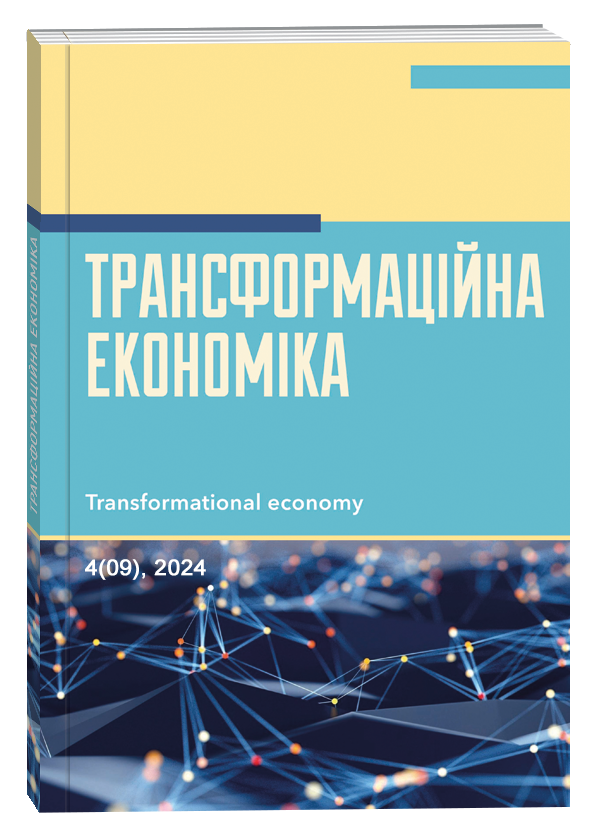MANAGERIAL APPROACH TO CONSIDERING SMART CITY AS A PUBLIC SPACE FOR SUSTAINABLE DEVELOPMENT
Abstract
The evolution of cities into sustainable and intelligent structures has come a long way thanks to the integration of Artificial Intelligence (AI) and the Internet of Things (IoT). This study systematically analyzes 133 scientific articles published between 2014 and 2021, mainly from Scopus (90%) and WoS (70%). Focusing on key areas of smart cities, such as healthcare, education, environment, waste management, mobility, agriculture, risk management, and security, the analysis explores the application of AI. The proliferation of AI for operational automation, data-driven decision-making, and environmental improvement is leading to regulatory challenges that include issues related to privacy, discrimination in service provision, and ethical considerations. The impact of AI adoption, especially in healthcare after the 2019 global health crisis, is emphasized, highlighting the key role of AI algorithms such as ANN, RNN/LSTM, CNN/R-CNN, DNN, and SVM/LS-SVM in shaping the trajectories of cities. This study provides insights into the multifaceted implications of AI in smart cities, offering a comprehensive overview of the benefits, challenges, and transformative potential of these technologies in various sectors of the urban environment. The development of smart cities based on the integration of AI and IP creates new opportunities for territory marketing and strategic development of regions. The use of advanced technologies not only improves the comfort and efficiency of residents' lives, but also makes regions more attractive for investment and business, which contributes to the growth of economic potential. Implementation of innovative solutions to optimize urban services helps to create the image of a progressive region capable of providing modern living and business conditions. Strategic development with an emphasis on environmental friendliness, safety and quality of services creates a competitive advantage for regions, attracting new residents and talent. Thus, smart cities are becoming an important factor in the long-term strategy of economic growth and sustainable development of regions, increasing their attractiveness at the global level.
References
Aguilera-Caracuel J., & Ortiz-de-Mandojana N. Green innovation and financial performance: An institutional approach. Organization & Environment, 2013. No. 26(4). P. 365-385.
Allam Z., Newman P. Redefining the smart city: Culture, metabolism and governance. Smart Cities. 2018. № 1. P. 2.
An Advanced Triple-Helix Network Model for Smart Cities Performance / Nijkamp P., Lombardi P., Giordano S. et al. Journal of Urban Technology. A Special Issue on Innovation. Research Memorandum. 2011. P. 45.
Anholt S. Competіtіve Іdentіty: The New Brand Management for Natіons, Cіtіes and Regіons. Palgrave Macmillan, 2007. 160 p.
Banerjee M., Lee J., Choo K. A blockchain future for internet of things security: A position paper. Digit. Commun. Netw. 2019. No. 4. P. 149–160.
Bennett D. City of Melbourne: pushing the boundaries of lean management applied in local government. Planet Lean. The Lean Global Network Journal. 2014. URL: https://planet-lean.com/melbourne-lean-government-cities (дата звернення: 15.10.2024).
Bigdeli Z., Kamal M., DeCesare S. Inter-Organisational Electronic Information Sharing in Local G2G Settings: A Socio-Technical Issue. 19th European Conference on Information Systems. Helsinki, 2013. URL: https://www.researchgate.net/publication/221409178_Inter-organisational_electronic_information_sharing_in_local_G2G_settings_A_socio-technical_issue (дата звернення: 18.10.2024).
Chourabi H., et al. Understanding Smart Cities: An Integrative Framework. 45th Hawaii International Conference on System Science (HICSS), Maui, HI, 4-7 January 2012. P. 2289-2297. DOI: https://doi.org/10.1109/HICSS.2012.615 (дата звернення: 20.10.2024).
Green, A., Grace, D., & Perkins, H. City branding research and practice: An integrative review. Journal of Brand Management, 2016. № 23. P. 252–272. DOI: https://doi.org/10.1057/bm.2016.8 (дата звернення: 20.10.2024).
Khan Arifur et al. Corporate governance and corporate social responsibility disclosures: Evidence from an emerging economy. Journal of business ethics, 2013. No. 114. P. 207-223. (дата звернення: 20.10.2024).
Kar A.K., Mustafa S.Z., Gupta M.P., Ilavarasan P.V., & Dwivedi Y.K. Understanding smart cities: Inputs for research and practice. In Advances in smart cities. 2017. P. 1-7. Chapman and Hall/CRC.
Sterbenz James P.G. Smart city and IoT resilience, survivability, and disruption tolerance: Challenges, modelling, and a survey of research opportunities. Conference: 2017 9th International Workshop on Resilient Networks Design and Modeling (RNDM). P. 1-6. IEEE. URL: https://ieeexplore.ieee.org/document/8093025 (дата звернення: 20.10.2024).
What is a smart city? – definition and examples. TWI-global. 2021. URL: https://www.twi-global.com/technical-knowledge/faqs/what-is-a-smart city (дата звернення: 20.10.2024).
What is IoT? Oracle. 2022. URL: https://www.oracle.com/cis/ internet-of-things/what-is-iot (дата звернення: 15.09.2024).
Андрієнко А. Оцінювання зрілості органів місцевого самоврядування великих міст України у сфері впровадження концепції «smart city» у повоєнний період. Вісник НТУ ДП. 2022. No. 1. С. 59–70.
Андрієнко А.О. Перспективи впровадження SMАRT-підходів до розвитку українських міст у воєнний і повоєнний період. Матеріали IV міжнародної науково-практичної інтернет-конференції «Формування ефективної системи управління та публічного адміністрування в умовах транзитивної економіки». Харків, 2022. С. 117–118.
Блокчейн і державне управління. Exbase. 2020. URL: https://exbase.io/uk/wiki/blokchejn-i-derzhavne-upravlinnya (дата звернення: 15.10.2024).
Визначено переможців конкурсу «Smart city Awards 2020». Асоціація міст України. 2022. URL: https://www.auc.org.ua/novyna/ vyznacheno-peremozhciv-konkursu-smart city-awards-2020 (дата звернення: 15.09.2024).
Дурман М.О., Дурман О.Л. Концептуальні підходи до цифрової трансформації освіти і науки. Вісник ХНТУ. 2021. No. 2. С. 127–137. DOI: https://doi.org/10.35546/kntu2078-4481.2021.2.16
Кукса В.М. Формування бренду міст України як необхідна складова їхнього розвитку. Фінансовий простір. 2018. № 3 (31). С. 110-117.
Маматова Т.В., Андрієнко А.О. Концепція «розумної територіальної громади» в контексті забезпечення інтелектуалізованого місцевого розвитку. Децентралізація влади в Україні: оцінювання результатів формування та розвитку самодостатніх громад: монографія / за заг. та наук. ред. С.М. Серьогіна, І.А. Чикаренко. Дніпро : ДРІДУ НАДУ, 2019. С. 73–84.
Рейтинг міст з погляду легкості ведення бізнесу від Forbes Ukraine. 2021. URL: https://forbes.ua/ratings/naykrashchi-mista-dlya-vedennya-biznesu-2021-05102021-2533 (дата звернення: 19.10.2024).
Слюсарева Л.В. Плейсбрендинг як маркетинговий інструмент розвитку територій. Бренд-менеджмент: маркетингові технології: матеріали V міжнародної наук.-практ. конференції (Київ, 14 березеня 2023 р.). Київ Держ.торг.-екон. ун-т, 2023. С. 276-280.
Сутність стратегії сталого розвитку регіону. URL: https://pidruchniki.com/1298010862973/rps/sutnist_strategiyi_stalogo_rozvitku_regionu (дата звернення: 11.11.2024).
Aguilera-Caracuel J., & Ortiz-de-Mandojana N. (2013) Green innovation and financial performance: An institutional approach. Organization & Environment, no. 26(4), pp. 365-385.
Allam Z., Newman P. (2018) Redefining the smart city: Culture, metabolism and governance. Smart Cities. no. 1, p. 2.
An Advanced Triple-Helix Network Model for Smart Cities Performance / Nijkamp P., Lombardi P., Giordano S. et al. (2011) Journal of Urban Technology. A Special Issue on Innovation. Research Memorandum. 45 р.
Anholt S. (2007) Competіtіve Іdentіty: The New Brand Management for Natіons, Cіtіes and Regіons. Palgrave Macmillan. 160 p.
Banerjee M., Lee J., Choo K. (2019) A blockchain future for internet of things security: A position paper. Digit. Commun. Netw. no. 4, pp. 149–160.
BennettD. (2014) City of Melbourne: pushing the boundaries of lean management applied in local government. Planet Lean. The Lean Global Network Journal. Available at: https://planet-lean.com/melbourne-lean-government-cities (accessed October 15, 2024).
Bigdeli Z., Kamal M., De Cesare S. (2013) Inter-Organisational Electronic Information Sharing in Local G2G Settings: A Socio-Technical Issue. 19th European Conference on Information Systems. Helsinki. Available at: https://www.researchgate.net/publication/221409178_Inter-organisational_electronic_information_sharing_in_local_G2G_settings_A_socio-technical_issue (accessed October 18, 2024).
Chourabi H., et al. (January 4-7, 2012) Understanding Smart Cities: An Integrative Framework. 45th Hawaii International Conference on System Science (HICSS), Maui, HI. Pp. 2289-2297. DOI: https://doi.org/10.1109/HICSS.2012.615 (accessed October 20, 2024).
Green A., Grace D., & Perkins H. (2016) City branding research and practice: An integrative review. Journal of Brand Management. no. 23, pp. 252–272. DOI: https://doi.org/10.1057/bm.2016.8. (accessed October 20, 2024).
Khan Arifur et al. (2013) Corporate governance and corporate social responsibility disclosures: Evidence from an emerging economy. Journal of business ethics, no. 114, pp. 207-223. (accessed October 20, 2024).
Kar A. K., Mustafa S. Z., Gupta M. P., Ilavarasan P. V., & Dwivedi Y. K. (2017) Understanding smart cities: Inputs for research and practice. In Advances in smart cities. Pp. 1-7. Chapman and Hall/CRC. (accessed October 20, 2024).
Sterbenz James P. G. (2017) Smart city and IoT resilience, survivability, and disruption tolerance: Challenges, modelling, and a survey of research opportunities. Conference: 2017 9th International Workshop on Resilient Networks Design and Modeling (RNDM). Pp. 1-6. IEEE. Available at: https://ieeexplore.ieee.org/document/8093025 (accessed October 20, 2024).
What is a smart city? – definition and examples. TWI-global. (2021). Available at: https://www.twi-global.com/technical-knowledge/faqs/what-is-a-smartcity (accessed October 20, 2024).
What is IoT? Oracle. (2022). Available at: https://www.oracle.com/cis/internet-of-things/what-is-iot (accessed September 15, 2024).
Andrienko A. (2022) Otsiniuvannia zrilosti orhaniv mistsevoho samovriaduvannia velykykh mist Ukrainy u sferi vprovadzhennia kontseptsii «smart city» u povoiennyi period. [Assessment of the maturity of local governments of large cities of Ukraine in the field of implementation of the «smart city» concept in the postwar period]. Bulletin of NTU SE. no. 1. pp. 59-70. (in Ukrainian)
Andrienko A. (2022) Perspektyvy vprovadzhennia SMART-pidkhodiv do rozvytku ukrainskykh mist u voiennyi i povoiennyi period. [Prospects for the implementation of SMART approaches to the development of Ukrainian cities in the war and post-war period]. Proceedings of the IV International Scientific and Practical Internet Conference «Formation of an Effective System of Management and Public Administration in a Transition Economy». Kharkiv, pp. 117-118. (in Ukrainian)
Blockchain and public administration. Exbase.io. (2020). Available at: https://exbase.io/uk/wiki/blokchejn-i-derzhavne-upravlinnya (in Ukrainian)
The winners of the Smart City Awards 2020 have been announced. Association of Ukrainian Cities. (2022). Available at: https://www.auc.org.ua/novyna/vyznacheno-peremozhciv-konkursu-smartcity-awards-2020 (in Ukrainian)
Durman M. O., Durman O. L. (2021) Kontseptualni pidkhody do tsyfrovoi transformatsii osvity i nauky. [Conceptual approaches to the digital transformation of education and science]. Bulletin of KNTU, no. 2, 127-137 pp. DOI: https://doi.org/10.35546/kntu2078-4481.2021.2.16 (in Ukrainian)
Kuksa V. M. (2018) Formuvannia brendu mist Ukrainy yak neobkhidna skladova yikhnoho rozvytku. [Formation of the brand of Ukrainian cities as a necessary component of their development]. Financial space. no. 3 (31), pp. 110-117. (in Ukrainian)
Mamatova T. V., Andrienko A. O. (2019) Kontseptsiia «rozumnoi terytorialnoi hromady» v konteksti zabezpechennia intelektualizovanoho mistsevoho rozvytku. [The concept of «smart territorial community» in the context of ensuring intellectualized local development]. Decentralization of power in Ukraine: assessment of the results of the formation and development of self-sufficient communities: monograph / under the general and scientific editorship of S. M. Seriogin, I. A. Chikarenko. Dnipro: DIDU NADU, pp. 73-84. (in Ukrainian)
Reitynh mist z pohliadu lehkosti vedennia biznesu vid Forbes Ukraine. (2022). Available at: https://brandukraine.org.ua/documents/27/UA_Ukraines_Global_Perception_Report_2022_WEB_28_02_2023.pdf (in Ukrainian)
Slyusareva L. V. (March 14, 2023) Pleysbrendynh yak marketynhovyy instrument rozvytku terytoriy [Place branding as a marketing tool for the development of territories]. Proceedings of the Brand management: marketing technologies: materials of the V International Scientific and Practical Conference. Kyiv: State University of Trade and Economics, pp. 276-280. (in Ukrainian)
The essence of the strategy of sustainable development of the region. Available at: https://pidruchniki.com/1298010862973/rps/sutnist_strategiyi_stalogo_rozvitku_re gionu (accessed November 11, 2024). (in Ukrainian)


